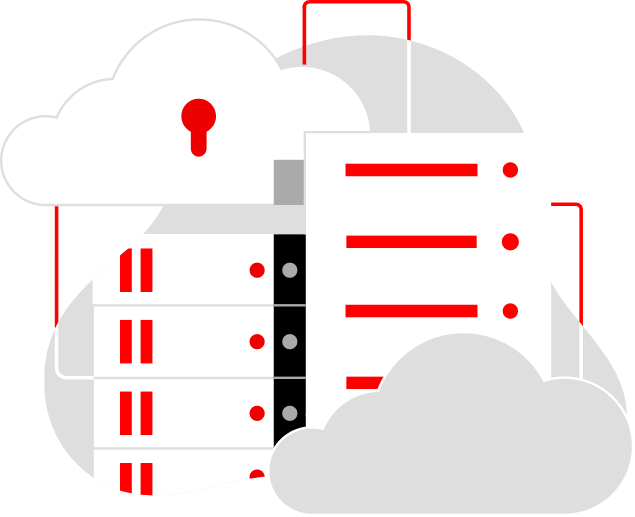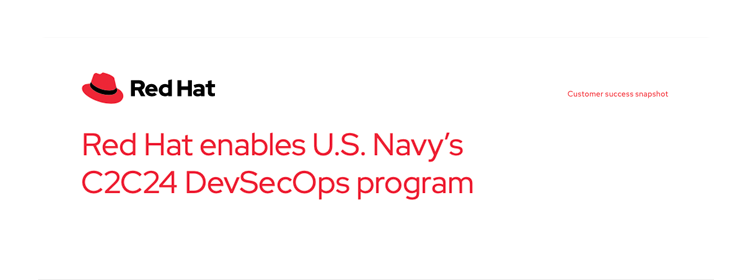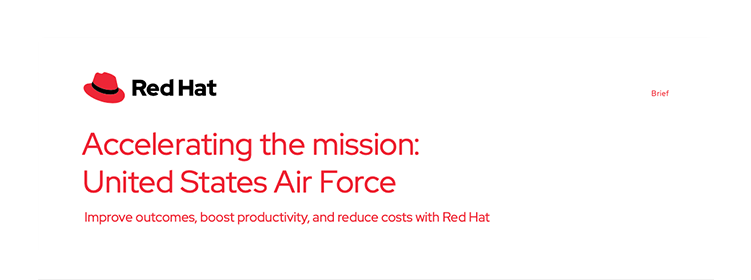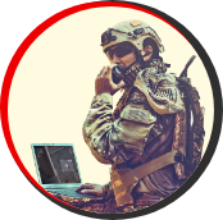DEPARTMENT OF DEFENSE
Move faster, with less risk
As the Department of Defense (DoD) moves to modernize its widespread resources, getting to mission capability faster is increasingly dependent on IT security. Red Hat has the open source technology and expertise to partner with the DoD to innovate with agility, standardize interoperability across all branches and agencies, and still maintain a high security protocol.
When a mission is critical, agility is everything
Modernize with agility across all branches and agencies
To protect national security and increase warfighter effectiveness, the DoD must become more agile while more securely distributing workloads and data across its infrastructures. This means taking apps and data into the field where people need it to close the threat capability gap and exceed enemy capacity. And as the largest federal department in the United States, the DoD needs to become more competitive by modernizing legacy infrastructure and outdated processes—without compromising the security of IT systems that are critical to its missions.
Through Multi-Domain Operations (MDO) and technology initiatives like Joint All-Domain Command and Control (JADC2), the DoD seeks to improve data availability and integration among and within service branch and coalition partner systems. And it seeks security-focused software supply chains with new capabilities to conduct effective military operations. Here, the goals are to reduce cognitive workloads on system users, increase operational readiness, and optimize the use of limited resources at the tactical edge.
Red Hat meets DoD security standards
Red Hat® OpenShift® is the only enterprise container platform with Federal Information Processing Standards (FIPS) compliance and multiple layers of federally certified security hardening, including FIPS 140-2 validated crypto and Common Criteria certified platforms. And Red Hat solutions align with the DoD Enterprise DevSecOps Reference Design (DEDSORD), an initiative that focuses on automating workflow, tools, and services to scale, as well as standards critical to the warfighter—including performance measurement capability.
Red Hat’s approach to DEDSORD offers a comprehensive platform solution for DevSecOps to meet agency standards for security, compliance, privacy, transparency, and trust. It also provides the necessary productive abstractions for DoD organizations to focus on delivering applications rather than technical details. It can be implemented anywhere Red Hat OpenShift Container Platform is deployed, including public cloud service providers, on-prem data centers, and edge and air-gapped environments.
Get to mission faster with DevSecOps
In a world where military weapons are increasingly vulnerable to hacks . . . military IT must bake security capabilities directly into application development processes and make them a core component of their infrastructures.
Responding with agility to evolving threats is a strength of the military. But with today’s rapid pace of technological innovation comes the DoD’s most pressing challenge—securing assets and intelligence across all branches and agencies.
As a partner in the modernization process, Red Hat can help the DoD make security more sustainable by supporting digital transformation through DevSecOps and the adoption of a comprehensive hybrid cloud solution that improves integration and interoperability among systems.
Transform complex networks to increase operational readiness
Getting to mission capability faster—with less risk— requires transformation of complex networks to improve interoperability of military efforts across all branch domains. These complex networks require significant time and resources to maintain technology infrastructures—while keeping combat systems secure and relevant for the future. The age and inflexibility of some platforms makes many systems vulnerable to attack.
Red Hat understands that the DoD faces unique challenges and must implement MDO strategies to integrate and coordinate command and control operations simultaneously across air, land, sea, space, and cyberspace domains.
Challenges to overcome to increase operational readiness include:
Challenges to overcome to increase operational readiness include:
Non-streamlined branch and agency operations
Multi-domain, data-driven battlefields require real-time intelligence to move the mission forward—as well as agile and faster access to critical data and applications across kinetic and cyber domains.
Software development modernization
Slow authority to operate (ATO) approvals and legacy software development processes impede the adoption of agile development practices and DevSecOps processes, which are essential for building flexible and scalable microservices-based applications.
Manual integration of information
Disconnected legacy systems force DoD personnel to manually collate data from multiple unintegrated systems. Transforming these networks and systems will provide much-needed file sharing, cloud collaboration, and information aggregation.
Resource constraints
Modernization is limited by legacy systems that consume a disproportionate share of operations and maintenance resources in a climate of disconnected funding processes and increasingly scrutinized defense budget pressures.
Legacy hardware systems
High risk-aversion and long-duration field-worthiness testing cycles impede system modernization by keeping older, obsolete technologies in service, which are costly to maintain and difficult to upgrade. Also legacy systems often hinder innovation and make it harder to recruit and retain skilled personnel.
Cultural transformation
Cultural shifts needed to modernize infrastructure are difficult, especially in organizations with vertical command structures and frequent staff rotation.
USE CASE
Red Hat solutions meet DoD operational needs
Since each military branch brings its own expertise and technology to the battlefield—and its respective physical and logistical limitations—it’s necessary to integrate All Command Operations (ACO), Joint All-Domain Operations (JADO), and MDO simultaneously across air, land, sea, space, and cyber domains to effectively coordinate and control operations.
As technology has progressed, so have the capabilities and sophistication of America’s near-peer adversaries. The DoD now needs to achieve the complex integration of its systems across all domains during the window of peak capability known as convergence to overwhelm adversary response capabilities. Red Hat’s portfolio of solutions effectively addresses DoD’s needs for data volume, variety, velocity, veracity and value across all domains.
Open standards
Ensure extensibility and interoperability between solutions and drive collaboration and innovation.
Red Hat Integration, an open standards-based, cloud-native integration portfolio allows for data-in-motion transformation and systems integration.
Edge computing and hybrid cloud architecture
Build MDO capabilities to effectively distribute and manage the high data volume workloads of a convergence event quickly, resiliently, elastically, and dynamically and support the volume and velocity of data during the event.
Red Hat OpenShift Container Platform underpins hybrid cloud capabilities.
Red Hat® Enterprise Linux® (RHEL) for edge provides an edge platform.
Tactical networks
Build MDO convergence opportunities for networks like sensors, the Internet of Things (IoT), and 5G networks to facilitate the thousands of devices pushing and pulling data across the battlefield.
Red Hat Data Services can more quickly and richly inform decisions and facilitate coordination between service branches and allies—and offer flexibility to dynamically adjust assets from one battle to the next.
Automation
Quickly and dynamically scale to ensure a consistent, rapid, repeatable deployment of underlying infrastructure.
Red Hat® Ansible® Automation Platform and Red Hat Satellite support IT automation and management.
Agile integration
Develop and operate a dynamic data fabric for data in motion and ensure data veracity and value can be derived from intelligence through event-driven, microservice architectures to feed human and artificial intelligence decision-making.
Red Hat AMQ can be used to develop event-driven microservice architectures for modern data streaming.
DoD relies on Red Hat
Red Hat enables U.S. Navy's C2C24 DevSecOps program
See how Red Hat helped the U.S. Navy address emergent cybersecurity vulnerabilities in near-real time, while also delivering new functionality and warfighting capabilities to operational forces.
Accelerating the mission: United States Air Force
When the U.S. Air Force needed new capabilities at the speed of need, Red Hat helped deliver in multiple contexts, including a traditional data center, the public cloud, and at the tactical edge.
Why Red Hat?
Red Hat’s holistic approach to digital transformation can help the DoD not only jumpstart its modernization efforts, but also serve as a reliable partner throughout the entire process. And as the DoD seeks technology to move to mission capability faster, and with less risk, our open hybrid cloud approach and comprehensive solutions informed by edge computing can equip the DoD to implement MDO and effectively conduct military operations across all service branches and agencies.
Dig deeper















